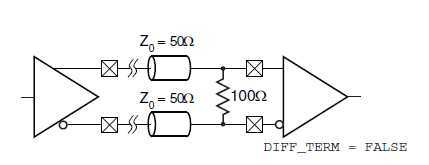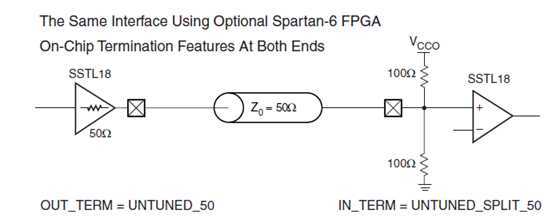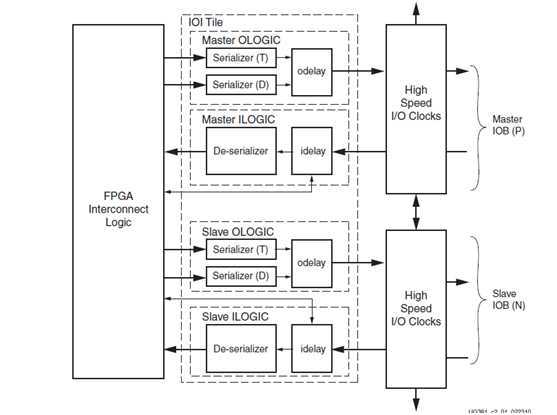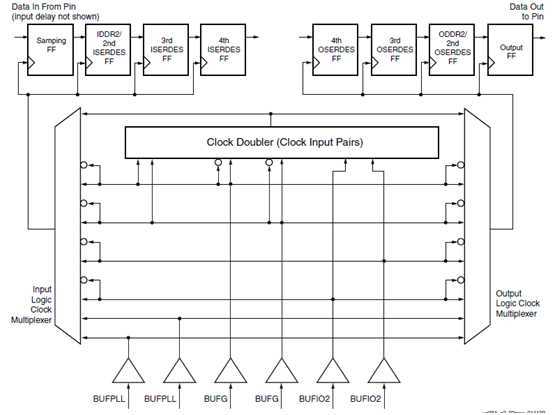标签:des style blog http os 使用 io ar for
对Spartan-6系列FPGA来说,一个IO Tile包括2个IOB、2个ILOGIC、2个OLOGIC、2个IODELAY。

图 1Spartan-6系列IO Tile结构图

图 2Spartan-6 FPGA I/O Banks
每个IOB包含了输入、输出、三态驱动器;这些驱动器可以配置为不同的电平标准如LVTTL、LVCMOS等;差分IO会用到1个IO Tile里的两个IOB。
每个IOB都被直接连接到了ILOGIC和OLOGIC,ILOGIC和OLOGIC可以被配置成ISERDES或OSERDES,。

图 3基本IOB结构图
高速IO电平标准的使用可以优化电平转换特性和信号完整性,在高速IO电平标准中往往需要使用终端电阻。终端电阻的位置应该距离接收器越近越好。
Spartan-6 FPGA为差分IO和单端IO提供了片内终端电阻,这个终端电阻位于IOB内部,使用这些终端电阻,可以避免FPGA外部再引脚处再接电阻。
Spartan-6系列为差分IO提供了100Ω的终端电阻,差分引脚的终端电阻可以通过约束文件使之使能或不使能。

图 4差分引脚使能终端电阻

图 5差分引脚不使能终端电阻
单端引脚的输入终端电阻和输出阻抗都是可编程控制的,如下图所示:左边FPGA的输出使能了50Ω的输出阻抗,右边的FPGA使能了输入50%分压电阻;在高速接口应用中,使能输出阻抗可以减少电磁反射,Spartan-6系列FPGA输出阻抗可选值为None、25Ω、50Ω、75Ω;输入阻抗可设置为25%、50%、75%分压。

图 6单向SSTL接口使用片上终端电阻
IOB内部有多种输入输出缓冲资源(buffer resource),他们可以原语的形式调用,在Spartan-6系列里,单端IO标准的原语如下5个:
|
原语 |
功能 |
|
IBUF |
输入缓冲 |
|
IBUFG |
时钟输入缓冲 |
|
OBUF |
输出缓冲 |
|
OBUFT |
输出三态缓冲 |
|
IOBUF |
输入输出缓冲 |
同时有7个差分IO标准的原语
|
原语 |
功能 |
|
IBUFDS |
输入缓冲 |
|
IBUFGDS |
时钟输入缓冲 |
|
IBUFDS_DIFF_OUT |
取反输出缓冲 |
|
IBUFGDS_DIFF_OUT |
时钟取反输出缓冲 |
|
OBUFDS |
输出缓冲 |
|
OBUFTDS |
三态输出缓冲 |
|
IOBUFDS |
输入输出IO缓冲 |
IOB支持多种电平标准,用户可以自由灵活地为自己的设计选择合适的IO电平标准,Spartan-6系列支持的IO电平标准如下
|
标准 |
解释 |
用途及厂商 |
输入缓冲 |
输出缓冲 |
|
单端IO电平标准 |
||||
|
LVTTL |
Low Voltage TTL |
General purpose 3.3V |
LVTTL |
Push-Pull |
|
LVCMOS |
Low Voltage CMOS |
General purpose |
CMOS |
Push-Pull |
|
PCI |
Peripheral Component Interconnect |
PCI bus |
LVTTL |
Push-Pull |
|
I2C |
Inter Integrated Circuit |
NXP |
CMOS |
Open drain |
|
SMBUS |
System Management Bus |
Intel |
CMOS |
Open drain |
|
SDIO |
Secure Digital Input Output |
SD Card Assoc, Memory Card |
CMOS |
Push-Pull |
|
Mobile DDR |
Low Power DDR |
|
CMOS |
Push-Pull |
|
HSTL |
High-Speed Transceiver Logic |
Hitachi SRAM; IBM; three of four classes supported |
Vref based |
Push-Pull |
|
HSTL18 |
High-Speed Transceiver Logic |
Hitachi SRAM; IBM; three of four classes supported |
Vref based |
Push-Pull |
|
SSTL3 |
Stub Series Terminated Logic for 3.3V |
SDRAM bus; Hitachi and IBM; two classes |
Vref based |
Push-Pull |
|
SSTL2 |
SSTL for 2.5V |
DDR SDRAM |
Vref based |
Push-Pull |
|
SSTL18 |
SSTL for 1.8V |
DDR SDRAM |
Vref based |
Push-Pull |
|
SSTL15 |
SSTL for 1.5V |
DDR SDRAM |
Vref based |
Push-Pull |
|
差分IO电平标准 |
||||
|
LVDS25 LVDS33 |
Low Voltage Differential Signaling |
High-speed interface, backplane, video; National, TI |
Differential Pair |
Differential Pair |
|
BLVDS |
Bus LVDS |
Bidirectional, multipoint LVDS |
Differential Pair |
Pseudo Differential Pair |
|
DISPLAY PORT |
Auxiliary channel interface for DISPLAY PORT |
Flat panel displays |
Differential Pair |
Pseudo Differential Pair |
|
LVPECL |
Low Voltage Positive ECL |
High-speed clocks |
Differential Pair |
N/A |
|
MINI_LVDS |
mini-LVDS |
Flat panel displays |
Differential Pair |
Differential Pair |
|
RSDS |
Reduced Swing Differential Signaling |
Flat panel displays |
Differential Pair |
Differential Pair |
|
TMDS |
Transition Minimized Differential Signaling |
Silicon Image; DVI/HDMI |
Differential Pair |
Differential Pair |
|
PPDS |
Point-to-Point Differential Signaling |
LCDs |
Differential Pair |
Differential Pair |
|
Differential Mobile DDR |
Differential LPDDR for CK/CK# |
|
Differential Pair |
Pseudo Differential Pair |
|
DIFF_HSTL_I DIFF_HSTL_III DIFF_HSTL_IV DIFF_HSTL_I_18 DIFF_HSTL_III_18 DIFF_HSTL_IV_18 |
Pseudo Differential HSTL |
SRAM |
Differential Pair |
Pseudo Differential Pair |
|
DIFF_SSTL3_I DIFF_SSTL3_II DIFF_SSTL2_I DIFF_SSTL2_II DIFF_SSTL18_I DIFF_SSTL18_II DIFF_SSTL15_II |
Pseudo Differential SSTL |
DDR, DDR2, DDR3 SDRAM |
Differential Pair |
Pseudo Differential Pair |
在默认情况下,在FPGA配置完成后,所有未使用的引脚将被配置成输入,并在IOB内部经下拉电阻接地,这种未使用引脚在配置后的状态可以通过UnusedPin BitGen option进行设定。
SelectIO的逻辑资源包括基本资源和高级资源,其中,基本资源包括:
高级资源包括:
selectIOn逻辑资源被组合在一个IO Tile内部,如下图所示,在单端模式中,master I/O buffer驱动P Pad,slave I/O buffer驱动N Pad;在差分模式中,master I/O buffer和slave I/O buffer组合起来使用,可以完成串并或者并串转换。

图 7一个I/OTile里的selectIO逻辑资源
所有IO的数据采集和转换(包括串并转换和并串转换)、DDR传输等都需要一个内部SDR时钟,为了实现这些功能,I/O接口Tile需要一个本地的时钟倍频器来获取SDR时钟。
进行DDR传输的倍频器需要两个输入时钟,这两个输入时钟必须是下面三种情况之一:

图 8IO接口逻辑的时钟资源
Spartan6系列之SelectIO深入详解及高级应用简介
标签:des style blog http os 使用 io ar for
原文地址:http://www.cnblogs.com/dhyc/p/3947101.html